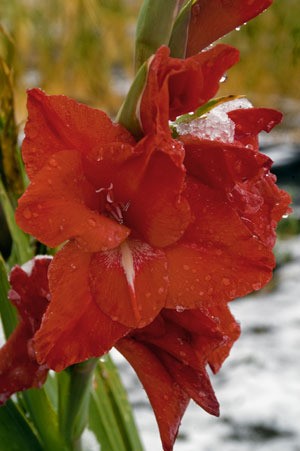My gardening attention span seems to be tied to the growth and die back of the plants in my garden. As they wake up each spring, I find myself full of energy and ambitious to take on various garden chores. As plants die back in the fall, however, my motivation tends to go dormant along with them. Although I can't resist the showy contributions they make to my perennials gardens, there are few chores I dread more than digging up tender bulbs and storing them for winter.
If you live in a zone where tender bulbs will not survive winter outdoors, here are some tips for making this task as quick and painless as possible.
Which Bulbs?
It's usually (although, not always) the summer bulbs that are considered "tender" or "semi-tender." These are planted in early spring or summer for blooms later the same season, and will not survive in the ground over winter in freezing temperatures. You can either treat them like annuals and replace them next year, or dig them up and store them over winter.
It's pretty safe to say that most summer bulbs are not hardy to Zones 6 and lower. Ranunculus, cannas, and calla lilies are considered "semi-tender." Certain cultivars have been known to be hardy to Zone 7, but only in ideal conditions. Gladioli and dahlias can stay in the ground over winter to Zone 8. Elephant ears, caladiums, and tuberous begonias like the "tropics." They are considered "tender" and are only hardy to Zone 9.
Hardiness Zones are helpful, but they are not foolproof. They do not account for specific site conditions and fluctuations in temperature. Therefore a bulb that overwinters successfully in Zone 7 may freeze in when it's planted in Zone 8. Always err on the side of caution or you'll risk disappointment. Just like any aspect of gardening, time and experience will provide you with the best answers.
Digging & Dividing
- Dig up the more cold tolerant tender bulbs (gladioli and dahlias) after the foliage has started to die back from frost. More sensitive bulbs (elephant ears, caladiums and begonias) should be lifted earlier to prevent damage. Leave all bulbs in the ground as long as you can to allow the bulbs to mature as much as possible.
- Use a fork or a sharp spade to gently loosen the soil several inches around the plant. Insert the spade's blade straight down into the soil to prevent slicing into nearby bulbs and gently lift out the bulb.
- Digging up bulbs when the soil is somewhat dry will result in less mud attached to the bulbs, making cleaning easier.
- With the exception of gladioli cormels, the storage organs of most tender bulbs can be left intact on the "parent" bulb until spring. This avoids division injuries prior to storage that will only increase the chances for disease and decay. Cut the rhizomes and tubers apart in the spring-making sure at least one or two dormant buds are present on each section.
Cleaning & Curing
- After digging, bulbs need to be "cured" (allowed to air dry) for anywhere from several hours to several days. Leave ball of roots and soil intact until bulbs finish curing. For gladioli, elephant ears, begonias, and calla lilies, shake off loose soil, cut tops to 1-2 inches above corm and dry at 60-70ºF for 2-3 weeks. For dahlias, cure roots for 1 to 2 hours before applying fungicide and storing. Cannas rhizomes should be cured for approximately 2 weeks before storage.
- Bulbs are often prone to infections from various fungi. To prevent attacks during storage, freshly dug bulbs should be dusted with a bulb fungicide before storage. Place bulbs (or corms or tubers) and formulated bulb dust inside a paper bag and shake vigorously to dust. Make sure to read and follow label directions carefully before using.
Storage
- Store only healthy, disease-free bulbs that remain visibly undamaged after digging.
- Store bulbs in cardboard boxes, paper or mesh bags or trays with screens that allow for good air circulation. Pack bulbs in 2-3 inches of peat moss, vermiculite, sphagnum moss, sawdust, or wood shavings.
- Prevent disease or decay from spreading among neighbors. Don't let your bulbs touch each other during storage.
Temperature
- Although each type of bulb has an "ideal" temperature for storage, it's not practical to try to create 10 different temperature zones in your basement or garage. Caladium, begonia, and calla lilies prefer slightly warmer temperatures (50-55ºF), but all other bulbs will do just fine if stored near 40ºF. If bulbs start to sprout, move them to a cooler temperature.
Monitoring Moisture
- You'll need to check on them frequently to monitor moisture conditions. Mold is an indication that storage conditions are too damp. Try dipping them in a mild beach solution and allow them to dry out for a few days before returning them to a dryer medium.
- Shriveling bulbs indicates conditions are too dry. Use a spray bottle to moisten the packing medium and cover them.

